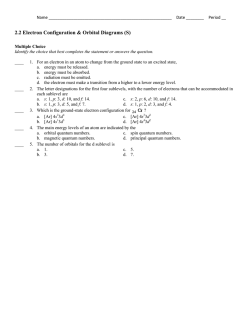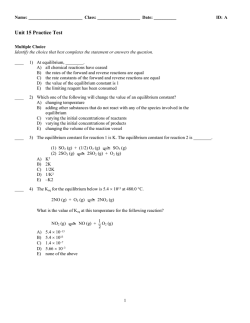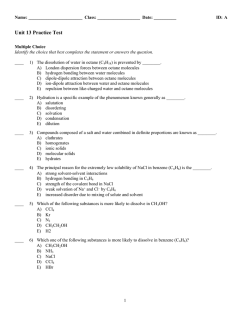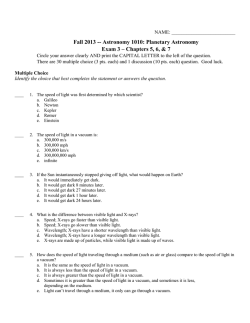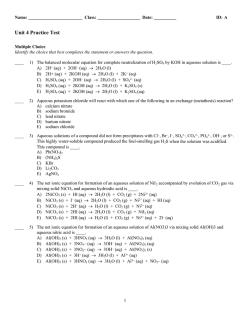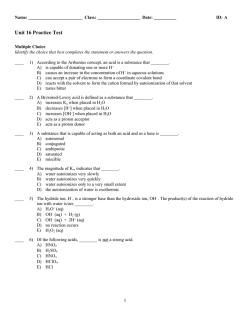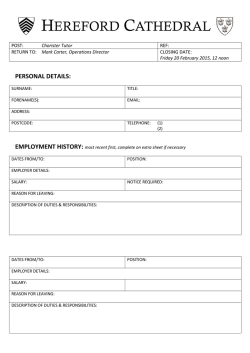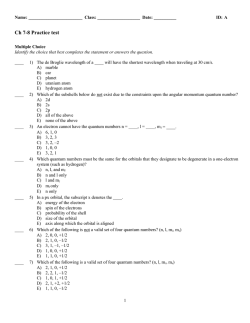
ExamView - Unit 7 Practice Mult.tst
Name: ________________________ Class: ___________________ Date: __________ Unit 7 Review Multiple Choice Identify the choice that best completes the statement or answers the question. ____ 1) In which set of elements would all members be expected to have very similar chemical properties? A) O, S, Se B) N, O, F C) Na, Mg, K D) S, Se, Si E) Ne, Na, Mg ____ 2) The effective nuclear charge of an atom is primarily affected by ____. A) inner electrons B) outer electrons C) nuclear charge D) electron distribution E) orbital radial probability ____ 3) Of the following, which gives the correct order for atomic radius for Mg, Na, P, Si and Ar? A) Mg > Na > P > Si > Ar B) Ar > Si > P > Na > Mg C) Si > P > Ar > Na > Mg D) Na > Mg > Si > P > Ar E) Ar > P > Si > Mg > Na ____ 4) Which of the following correctly represents the second ionization of aluminum? A) Al+ (g) + e– Al (g) B) Al (g) Al+ (g) + e– C) Al– (g) + e– Al2– (g) D) Al+ (g) + e– Al2+ (g) E) Al+ (g) Al2+ (g) + e– ____ 5) The list that correctly indicates the order of metallic character is ____. A) Sr > Ca > Mg B) F > Cl > Br C) C > Ge > Si D) Li > Na > K E) O > Se > S ____ 6) The acidity of carbonated water is due to the ____. A) presence of sulfur B) reaction of CO2 and H2O C) addition of acid D) nonmetal oxides E) none of the above 1 ID: A Name: ________________________ ID: A ____ 7) Between which two elements is the difference in metallic character the greatest? A) Rb and O B) O and I C) Rb and I D) Li and O E) Li and Rb ____ 8) The alkali metal that is naturally radioactive is ____. A) rubidium B) cesium C) lithium D) francium E) sodium ____ 9) Which element is solid at room temperature? A) Cl2 B) F2 C) Br2 D) I2 E) H2 ____ 10) The noble gases were, until relatively recently, thought to be entirely unreactive. Experiments in the early 1960s showed that Xe could, in fact, form compounds with fluorine. The formation of compounds consisting of Xe is made possible by ____. A) the availability of xenon atoms B) xenon's noble gas electron configuration C) the stability of xenon atoms D) xenon's relatively low ionization energy E) xenon's relatively low electron affinity ____ 11) Astatine has a(n) ____ density and a(n) ____ atomic radius compared to iodine. A) greater; greater B) smaller; greater C) smaller; smaller D) greater; smaller E) equal; equal ____ 12) An electron in a ____ subshell experiences the greatest effective nuclear charge in a many-electron atom. A) 3f B) 3p C) 3d D) 3s E) 4s ____ 13) Metals can be ____ at room temperature. A) liquid only B) solid only C) solid or liquid D) solid, liquid, or gas E) liquid or gas 2 Name: ________________________ ID: A ____ 14) The element(s) ____ could be used to produce a red or crimson color in fireworks. A) Mg or Ba B) Sr C) Ca, Sr, or Li D) Ba E) Na or K ____ 15) The most common sulfur ion has a charge of ____. A) 2– B) 1– C) 4+ D) 6+ E) Sulfur does not form ions. ____ 16) The only noble gas that does not have the ns2np6 valence electron configuration is ____. A) radon B) neon C) helium D) krypton E) All noble gases have the ns2np6 valence electron configuration. ____ 17) Of the halogens, which are gases at room temperature and atmospheric pressure? A) fluorine, bromine, and iodine B) fluorine, chlorine, and bromine C) fluorine, chlorine, bromine, and iodine D) fluorine, chlorine, and iodine E) fluorine and chlorine ____ 18) ____ is isoelectronic with krypton. A) Se2– B) Se3– C) Br D) Se2+ E) Te2– ____ 19) Which one of the following atoms has the largest radius? A) In B) Sn C) Sb D) Te E) I ____ 20) The ion with the smallest diameter is ____. A) Li+ B) Na+ C) K+ D) Rb+ E) Cs+ 3 Name: ________________________ ID: A ____ 21) Of the elements below, ____ is the most metallic. A) Sn B) P C) Br D) Rn E) As ____ 22) All of the following are ionic compounds except ____. A) CH4 B) K2O C) Be(OH)2 D) NiCl2 E) Sr3N2 Short Answer 1) The degree of interaction between two electrical charges depends on the ________ and the ________ of the charges and the distance between them. 2) As successive electrons are removed from an element, the ionization energy ________. 3) Which noble gas has the highest first ionization energy? 4) When electrons are removed from a lithium atom, they are removed first from which orbital? 5) An added electron to the element bromine goes into which orbital? 6) Write the balanced reaction between zinc oxide and sulfuric acid. 7) What are the elements called that are located between the metals and nonmetals? 8) Complete the following: P4O10 + 6H2O 9) Which metal is a liquid at room temperature? 10) [Xe]6s2 is the electron configuration for ________. 11) [Kr]5s2 is the electron configuration for ________. 12) In their compounds, the charges on the alkali metals and the alkaline earth metals are ________ and ________, respectively. 13) Which alkali metals can react with oxygen to form either the peroxide or the superoxide? 14) Write the balanced equation for the reaction of potassium with water. 15) Of the alkaline earth metals, which two elements are the least reactive? 4 Name: ________________________ ID: A 16) Write the balanced equation for the reaction of elemental fluorine with liquid water. 17) Write the balanced equation for the reaction of elemental chlorine with liquid water. 18) List seven nonmetals that exist as diatomic molecules in their elemental forms. 19) All of the group VIA elements are solids except ________. 20) Which noble gas has the lowest first ionization energy? True/False Indicate whether the statement is true or false. ____ 1) The effective nuclear charge acting on an electron is larger than the actual nuclear charge. ____ 2) The effective nuclear charge in an atom is proportional to the number of nuclear protons. ____ 3) The atomic radius of iodine is one-half the distance separating the iodine nuclei. ____ 4) A group of ions all containing the same number of electrons constitutes an isoelectronic series. ____ 5) Elements that readily conduct electricity are elements with low ionization energies. ____ 6) Electron affinity measures how easily an atom gains an electron. ____ 7) Xenon can form compounds with fluorine. 5 ID: A Unit 7 Review Answer Section MULTIPLE CHOICE 1) ANS: OBJ: 2) ANS: OBJ: 3) ANS: OBJ: 4) ANS: OBJ: 5) ANS: OBJ: 6) ANS: OBJ: 7) ANS: OBJ: 8) ANS: OBJ: 9) ANS: OBJ: 10) ANS: OBJ: 11) ANS: OBJ: 12) ANS: OBJ: 13) ANS: OBJ: 14) ANS: OBJ: 15) ANS: OBJ: 16) ANS: OBJ: 17) ANS: OBJ: 18) ANS: OBJ: 19) ANS: OBJ: 20) ANS: OBJ: 21) ANS: OBJ: A PTS: G2 A PTS: 7.2; G2 D PTS: 7.2, 7.3, 7.4, 7.5; G2 E PTS: 7.4; G2 A PTS: 7.6; G2 B PTS: 7.6; G2 A PTS: 7.6; G2 D PTS: 7.7, 7.8; G2 D PTS: 7.8; G2 D PTS: 7.8; G2 A PTS: 7.8; G2 D PTS: 7.2; G2 C PTS: 7.6; G2 B PTS: 7.7, 7.8; G2 A PTS: 7.8; G2 C PTS: 7.8; G2 E PTS: 7.8; G2 A PTS: 7.3; G2 A PTS: 7.3; G2 A PTS: 7.2, 7.3, 7.4, 7.5; G2 A PTS: 7.6; G2 1 DIF: 1 REF: Page Ref: 7.1 1 DIF: 3 REF: Page Ref: 7.2 1 DIF: 1 REF: Page Ref: 7.3 1 DIF: 1 REF: Page Ref: 7.4 1 DIF: 1 REF: Page Ref: 7.6 1 DIF: 3 REF: Page Ref: 7.6 1 DIF: 1 REF: Page Ref: 7.6 1 DIF: 2 REF: Page Ref: 7.7 1 DIF: 1 REF: Page Ref: 7.8 1 DIF: 1 REF: Page Ref: 7.8 1 DIF: 4 REF: Page Ref: 7.8 1 DIF: 1 REF: Page Ref: 7.2 1 DIF: 1 REF: Page Ref: 7.6 1 DIF: 1 REF: Page Ref: 7.7 1 DIF: 1 REF: Page Ref: 7.8 1 DIF: 1 REF: Page Ref: 7.8 1 DIF: 2 REF: Page Ref: 7.8 1 DIF: 1 REF: Page Ref: 7.3 1 DIF: 1 REF: Page Ref: 7.3 1 DIF: 1 REF: Page Ref: 7.4 1 DIF: 1 REF: Page Ref: 7.6 1 ID: A 22) ANS: A OBJ: 7.7, 7.8; G2 PTS: 1 DIF: 1 DIF: 3 REF: Page Ref: 7.2 PTS: 1 DIF: 2 OBJ: 7.2, 7.3, 7.4, 7.5; G2 3) ANS: helium REF: Page Ref: 7.4 PTS: 1 DIF: 2 OBJ: 7.2, 7.3, 7.4, 7.5; G2 4) ANS: 2s1 REF: Page Ref: 7.4 PTS: 1 OBJ: 7.3; G2 5) ANS: 4p REF: Page Ref: 7.4 SHORT ANSWER 1) ANS: signs, magnitude PTS: 1 OBJ: 7.2; G2 2) ANS: increases DIF: 2 PTS: 1 DIF: 2 OBJ: 7.3; G2 6) ANS: ZnO + H2SO4 ZnSO4 + H2O REF: Page Ref: 7.5 PTS: 1 OBJ: 7.6; G2 7) ANS: metalloids DIF: 1 REF: Page Ref: 7.6 PTS: 1 OBJ: 7.6; G2 8) ANS: 4H3PO4 DIF: 1 REF: Page Ref: 7.6 PTS: 1 OBJ: 7.6; G2 DIF: 1 REF: Page Ref: 7.6 2 REF: Page Ref: 7.7 ID: A 9) ANS: Mercury (Hg) PTS: 1 OBJ: 7.6; G2 10) ANS: barium DIF: 1 REF: Page Ref: 7.6 PTS: 1 OBJ: 7.6; G2 11) ANS: strontium DIF: 2 REF: Page Ref: 7.6 PTS: 1 OBJ: 7.6; G2 12) ANS: 1+, 2+ DIF: 2 REF: Page Ref: 7.6 PTS: 1 OBJ: 7.7; G2 13) ANS: K, Rb, and Cs DIF: 1 REF: Page Ref: 7.7 PTS: 1 DIF: 1 REF: Page Ref: 7.7 OBJ: 7.7; G2 14) ANS: 2K (s) + 2H2O(l) 2KOH (aq) + H2 (g) PTS: 1 OBJ: 7.7, 7.8; G2 15) ANS: Be and Mg DIF: 3 REF: Page Ref: 7.7 PTS: 1 DIF: 3 REF: Page Ref: 7.7 OBJ: 7.7; G2 16) ANS: 2H2O (l) + 2F2 (g) 4HF (aq) + O2 (g) PTS: 1 DIF: 1 REF: Page Ref: 7.8 OBJ: 7.8; G2 17) ANS: Cl2 (g) + H2O (l) HCl (aq) + HOCl (aq) PTS: 1 OBJ: 7.8; G2 DIF: 1 REF: Page Ref: 7.8 3 ID: A 18) ANS: hydrogen, oxygen, nitrogen, fluorine, chlorine, bromine, iodine PTS: 1 OBJ: 7.8; G2 19) ANS: oxygen DIF: 2 REF: Page Ref: 7.8 PTS: 1 OBJ: 7.8; G2 20) ANS: radon DIF: 2 REF: Page Ref: 7.8 PTS: 1 OBJ: 7.8; G2 DIF: 3 REF: Page Ref: 7.8 PTS: 1 DIF: 1 REF: Page Ref: 7.2 PTS: 1 DIF: 3 REF: Page Ref: 7.2 PTS: 1 DIF: 1 REF: Page Ref: 7.3 PTS: 1 DIF: 1 REF: Page Ref: 7.3 PTS: 1 DIF: 2 REF: Page Ref: 7.4 PTS: 1 DIF: 2 REF: Page Ref: 7.5 PTS: 1 DIF: 1 REF: Page Ref: 7.8 TRUE/FALSE 1) ANS: OBJ: 2) ANS: OBJ: 3) ANS: OBJ: 4) ANS: OBJ: 5) ANS: OBJ: 6) ANS: OBJ: 7) ANS: OBJ: F 7.2; G2 F 7.2; G2 T 7.3; G2 T 7.3; G2 T 7.4; G2 T 7.5; G2 T 7.8; G2 4 Unit 7 Review [Answer Strip] A _____ 1) A _____ 2) ID: A A _____ 7) B 14) _____ A 21) _____ D _____ 8) A 15) _____ A 22) _____ D _____ 9) C 16) _____ F _____ 1) F _____ 2) T _____ 3) D _____ 3) D 10) _____ E 17) _____ T _____ 4) T _____ 5) T _____ 6) E _____ 4) A 18) _____ A 11) _____ A _____ 5) A 19) _____ D 12) _____ B _____ 6) A 20) _____ C 13) _____ T _____ 7)
© Copyright 2024
